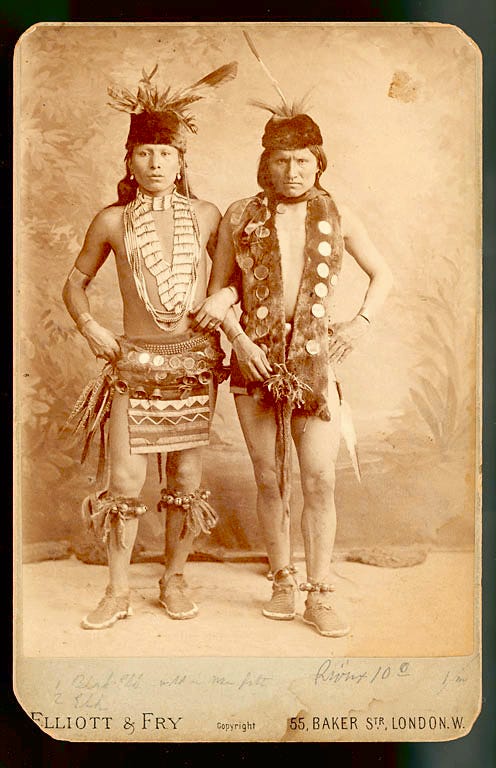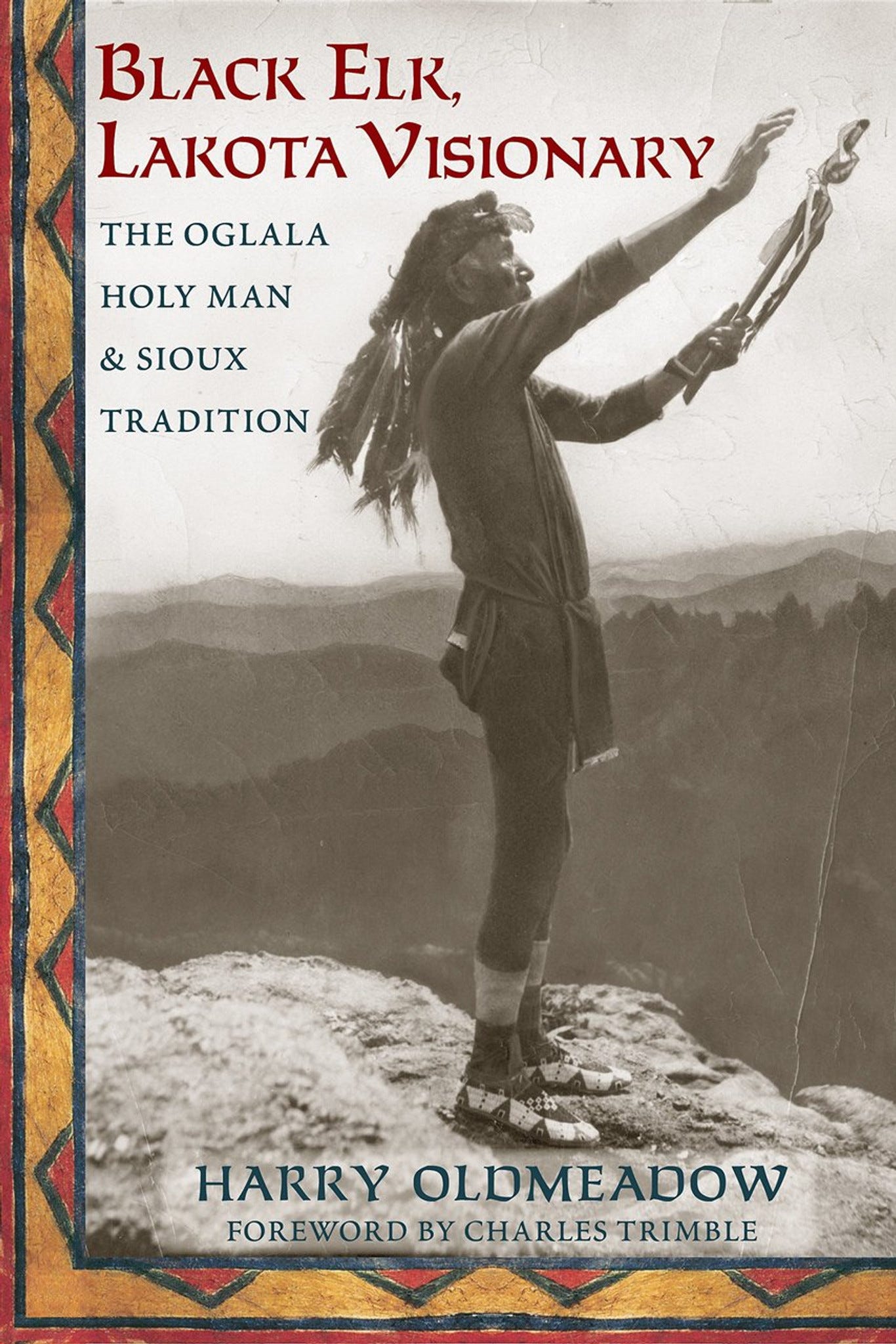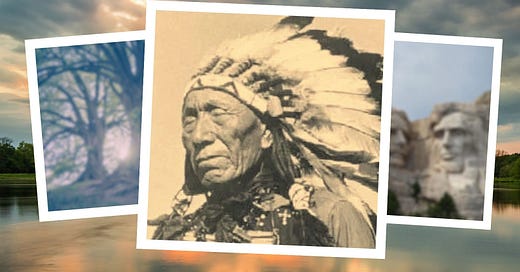Dear friend,
This past week, I enjoyed a brief phone call with one of our fellow travelers on this journey toward The Inspired Life. She taught me that she wakes up in the morning and says,
“God of Surprises, show us your face!”
Today, I am going to share with you a story from my life that qualifies not only as a series of surprises, but also the reason that I did something I never, ever thought I’d ever do…
I formally submitted stories of heavenly favors to the Cause for the Canonization of Nicholas Black Elk. That means; I experienced things that were so profoundly remarkable and connected with Nicholas Black Elk that I thought they ought to be considered as evidence toward his being recognized by the Catholic Church as someone united with our Creator in heaven.
Who?
Before you can appreciate these miraculous surprises, you’ll need to understand who Nicholas Black Elk is. I will do my best, in this short retelling, to respect his friends and relatives. To any of them who may read this, I humbly say; Black Elk has become for me a spiritual Grandfather. Thank you for carrying on his legacy.

Heȟáka Sápa (Black Elk) was born at Little Powder River on December 1, 1863 into the Oglala Lakota people of North America’s Great Plains. He is known for the bestselling book by John Niehardt, Black Elk Speaks (originally published in 1932), which narrates and interprets part of his extraordinary life story.
Black Elk was the second cousin of the warrior Crazy Horse, and as a child he was in the Battle of Little Big Horn, known by some as Custer’s Last Stand.
When he was nine years old, Black Elk fell unconscious and lay this way for several days, during which he later reported experiencing a profound, mystical vision containing deeply symbolic images. Here is one excerpt:
…I was seeing in a sacred manner the shapes of all things in the spirit, and the shape of all shapes as they must live together like one being. And I saw that the sacred hoop of my people was one of many hoops that made one circle, wide as daylight and as starlight, and in the center grew one mighty flowering tree to shelter all the children of one Mother and one Father. And I saw that it was holy.1
Black Elk’s father and paternal uncles were medicine men, a role which Black Elk also took on.
You’ll need to understand his identity as heyoka to appreciate my story. A heyoka is a sacred role in Great Plains Sioux cultures which could be described as a ‘holy contrarian.’ That is, he called his people’s attention to spiritual realities by speaking and acting in surprising ways. Some definitions describe a heyoka as a “sacred clown,” but I prefer not to use this terminology because we associate clowns with entertainment. If you’re familiar with the teachings of Jesus or other Jewish rabbis, you may perhaps relate the ways of the heyoka to rabbinic hyperbole. For example, Jesus said: “If your right eye causes you to sin, tear it out.” By surprising his listeners, he was teaching them something. Black Elk was known for both his wisdom and his great sense of humor.
While a young man, Black Elk joined Buffalo Bill’s Wild West show and toured across Europe. Queen Victoria, in fact, was so impressed by the performance that she bowed to him. A man of deep reflection, Black Elk considered his European tour an opportunity to study the culture and language of the wašíču (wasi’-chu, meaning ‘one who takes the fat of the buffalo and leaves the carcass,’ is the Sioux term for ‘White Man’).
By this point, the U.S. government had systemically disenfranchised, abused, betrayed, and enacted genocide on Native Americans. Many Christian religious institutions cooperated with the government in these acts. When Black Elk returned to the States, he participated in the Ghost Dance movement and was present at the Wounded Knee Massacre.
Afterward, he spent his time raising his family, caring for his people, and teaching others about the ways of the Lakota through demonstrative presentations, including at Mount Rushmore — which was carved into the Black Hills, a sacred site for the indigenous peoples which they had named Six Grandfathers.
His first wife, Katie, converted to Catholicism and their children were baptized. Following her death, Black Elk had his own personal conversion experience and was baptized Nicholas. He became a Catholic catechist — which was close to the present role of a permanent deacon. One of my favorite facts about Black Elk is that he measured distances by how many Rosaries it took to walk to a place.
He never gave up his Lakota ways.
Nicholas Black Elk passed away from this life on August 19, 1950.
The United States Board on Geographic Names in August 2016 officially renamed Harney Peak, the highest point in the Black Hills, to Black Elk Peak.
My First Surprise
Now, here is some of my story.
In 2015, Pope Francis published a teaching document about caring for God’s Creation, Laudato si’.
I, however, could barely keep a succulent alive. I had no pets, many allergies, and easily gained a sun rash. (I still do!) Yet, from the minute I learned about Laudato si’, I felt a deep desire and conviction that I needed to study this document in a group setting. For years, I never encountered that opportunity. Neither did I take the initiative to read the document myself; something silently told me… ‘Not yet.’
The film Wakanda Forever released in October 2022. I had never strongly identified with my indigenous American heritage, but after seeing Hollywood take my Mesoamerican ancestors seriously, I was compelled to better understand my indigenous ancestors on their own terms. In December of that year, I began a process of inquiry and research related to their beliefs and my own Catholic faith. How could I hold both of these identities at the same time, when so many voices gave me the impression that they greatly conflicted?
Three months later, I received an email from my local Roman Catholic diocese which included an announcement for an Internet-based training program through the Laudato Si’ Movement. Without studying what this entailed, I immediately recognized that this was my long-awaited opportunity to study Laudato si’. So, I enrolled in the program.
Laudato si’ advocates for a greater respect and involvement of indigenous peoples’ wisdom within wider society and the Church, as in this excerpt:
…It is essential to show special care for indigenous communities and their cultural traditions. They are not merely one minority among others, but should be the principal dialogue partners, especially when large projects affecting their land are proposed. For them, land is not a commodity but rather a gift from God and from their ancestors who rest there, a sacred space with which they need to interact if they are to maintain their identity and values. When they remain on their land, they themselves care for it best.2
However, I was not aware of this aspect of the document. I only knew of its connection to ecology.
An Unexpected Sign
As it happens, at the time of my enrollment, I was learning about the life and legacy of Nicholas Black Elk. In March 2023, I came across his name on the Internet as an indigenous Catholic holy figure.
Throughout my Laudato Si’ Animator training period, I continued learning about him on my own time, walking with Black Elk’s wisdom without realizing that this was all simultaneously occurring. (Hindsight is 20/20!)
To complete my LSA certification, I was required to complete a capstone project. I chose to lead small groups of reflection, discussion, study and action, related to care for Creation.
After I recruited members for three groups, we all decided on pre-scheduled times to meet via virtual video call.
Meanwhile, I began listening to some podcast interviews about Black Elk’s life during my commute to work each morning that week.
To my disappointment, the first of my three groups, the Tuesday Group, informed me that they could not meet due to schedule conflicts.
The same thing happened with the Wednesday Group.
Tempted towards total discouragement, I fought against it, and hoped that the Friday Group would be able to meet.
It was Friday morning when I finished listening to the final podcast I’d downloaded about Black Elk. Sitting in my car parked at my workplace on Friday morning, I prayed, asking Nicholas Black Elk to intercede for me and for our small groups to be able to begin our journey together. It was the last chance that week for a pre-scheduled meeting to actually convene.
Unfortunately, that morning I received yet another reason to be discouraged; notice from one of the group members that she wouldn’t be able to meet.
At noon, I started the group call. A second member declined and couldn’t join. I began to wonder, “Should I just call it off? Is this idea a total failure? How can we start a solid foundation like this?”
Four minutes passed as the call continued to ring…
Finally, the single remaining group member answered. We held the first group meeting with just the two of us, but the discussion was so fruitful. By the end, I felt blessed, hopeful, and encouraged to proceed with facilitating the groups.
Honestly, I do not recall thinking about Black Elk at that point.
A few hours later, I received an email from my mother-in-law, who was on a road trip with my father-in-law in Canada. Previously, they had sent me and my husband their road trip itinerary — and I should add that they are precise and diligent planners. However, this new email announced a surprise: they had decided to re-route their road trip to visit Mount Rushmore the following day. Attached to the email was a picture of Mount Rushmore.
When I saw the photo, the connection with Black Elk became so clear in my mind… I was stunned!
Mount Rushmore is in the Black Hills; an ecologically complex area which is sacred to the Lakota people.
The highest point in the Black Hills is named after Nicholas Black Elk.
Black Elk Peak sits just three miles south of Mount Rushmore.
Additionally, after seeing the photo that my mother-in-law had attached showing the faces on Mount Rushmore, I remembered that Nicholas’ son, Benjamin Black Elk, had been called “the fifth face of Mount Rushmore,” due to his years of service greeting visitors there.
My in-laws had received no communication from me whatsoever about Nicholas Black Elk, the Lakota, the Black Hills, or Mount Rushmore. Further, since they hadn’t yet visited, they had no reason to attach a photo of the famous landmark. Neither had I communicated with them about the progress of my LSA project. The fact that they are extremely careful planners also added to my surprise — that they’d decided to change their itinerary on that particular day, to that particular place, and that I’d received their email shortly after my prayer had been answered.
This unexpected email I took as a sign that Nicholas Black Elk had heard my request for his intercession. Through the grace of God, I received this sign as an encouragement in the face of reasons to be discouraged. Although it seemed that the small groups had not been going in the ‘right’ direction, I was taught that God is 're-routing' us all in a new direction, and we must press on in hope.
As Luther Standing Bear said:
The Lakota loved the sun and earth, but he worshipped only Wakan-Tanka, or Big Holy, who was the Maker of all things of earth, sky, and water. Wakan-Tanka breathed life and motion into all things, both visible and invisible. He was over all, through all, and in all, and great as was the sun, and good as was the earth, the greatness and goodness of the Big Holy were not surpassed. The Lakota could look at nothing without at the same time looking at Wakan-Tanka, and he could not, if he wished, evade His presence, for it pervaded all things and filled all space. All the mysteries of birth, life, and death; all the wonders of lightning, thunder, wind, and rain were but the evidence of His everlasting and encompassing power.3
I shared Nicholas Black Elk’s sign with my small group members, and with my mother-in-law and father-in-law. When they visited Mount Rushmore, they bought three books for me about Nicholas Black Elk from the gift shop, and mailed them to me. I considered this the ‘end’ of his wonderful sign.
Further Signs
However, his signs have continued in a very personal and unexpected way.
In late June and early July 2023, my husband and I visited his parents for a week. I decided to bring one of the books from Mount Rushmore as my reading material. Since this was going to be the first book I’d ever read about Black Elk, I prayerfully asked him to intercede in my selection of the book from among the three.

To my surprise, each chapter that I read held a connection to some simultaneous occurrence on our trip.
What happened on that journey involves the privacy of another person which I will respect here, but I will tell you that it unfolded in a way not unlike the first… A surprising connection to Black Elk affected someone so strongly that they acted in a way totally opposite to their usual personality, and this action led to an unexpected interior healing from a wound of being profoundly betrayed. It was the answer to years of prayer.
That story we also submitted to Nicholas Black Elk’s Cause for Canonization.
Great Surprises
I’m grateful for these signs from heaven which I am convinced came through the intercession of Nicholas Black Elk.
As I wrote down these thoughts for the first time, I realized how fitting it would be that he, who lived as a healer and a reconciler in this life as well as a heyoka, would intercede for us in such unexpected ways.
I shared the story of my first sign with Dr. Damian Costello, who is a theologian promoting the life of Nicholas Black Elk. He replied: “The kind of unexpected presence you describe has been a repeated part of my own journey.”
Additionally, thanks to Grandfather Black Elk’s example, I now understand that I can embrace my indigenous identity alongside my Catholic identity.
I believe that indigenous wisdom will continue to play a miraculous part in the rehabilitation and reconciliation that is so desperately needed on our planet, as Nicholas Black Elk saw in his visions.
Grandfather Black Elk, pray for us. Help us to smile and hope.
“God of Surprises, show us your face!”
Love,
Angela
DeMallie, Raymond J (1984). The Sixth Grandfather: Black Elk's teachings given to John G. Neihardt
Pope Francis (2015). Laudato si, no. 146.
Luther Standing Bear (1933), Land of the Spotted Eagle, 197.





Ever since Jimmy and I did our podcast episode on Nicholas Black Elk, I have greatly admired him. Thanks for sharing.
Thank you for sharing this reflection!